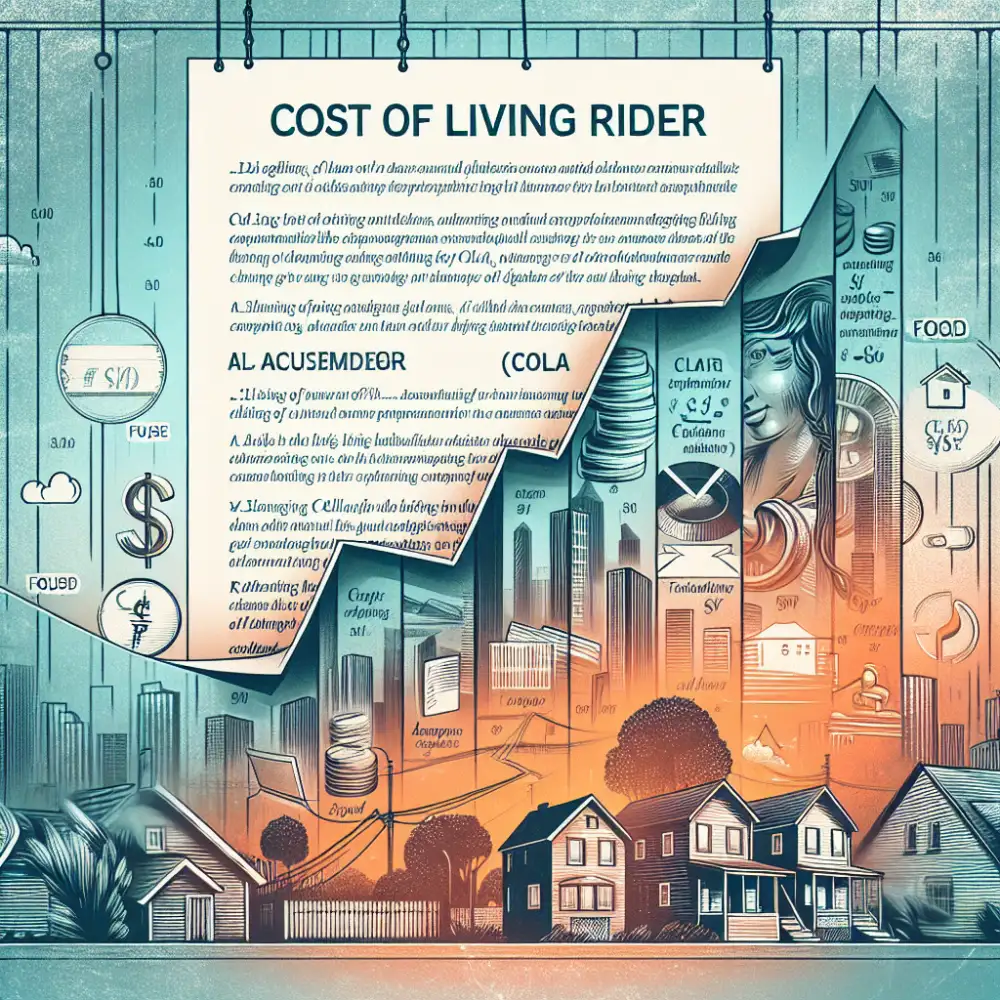Beat Inflation With The Cost Of Living Rider

Cost of living rider definition
A cost of living rider, often called a COLA rider, is an add-on to certain contracts, like insurance policies or retirement plans, that helps your payments keep pace with inflation. Think of it as a safety net to protect your purchasing power. Here's how it works: a cost of living rider includes a clause that allows for periodic adjustments to your payments based on changes in a specific index, typically the Consumer Price Index (CPI). The CPI measures the average change in prices paid by urban consumers for a basket of goods and services.
Let's say you have a life insurance policy with a $500,000 death benefit and a cost of living rider tied to the CPI. If the CPI increases by 3% in a year, your death benefit might increase by a similar percentage, potentially becoming $515,000. This adjustment helps ensure that the payout from your policy maintains its value over time, even as the cost of goods and services rises.
Cost of living riders are particularly beneficial for long-term contracts where inflation can significantly erode the value of future payments. They provide peace of mind knowing that your income or benefits are more likely to keep up with the rising cost of living, preserving your financial security.
How it works
A cost-of-living rider (COLA) is a contractual clause that adjusts payments to keep pace with inflation. It's like a built-in raise that kicks in when the cost of goods and services goes up. This rider is commonly found in long-term contracts, such as:
Retirement plans
Employment agreements
Lease agreements
Annuity contracts
COLA riders are designed to protect the purchasing power of your money over time. Without this rider, inflation could erode the value of your payments. Imagine receiving the same fixed payment for 20 years while the prices of groceries, gas, and housing continue to climb. Your money wouldn't stretch nearly as far.
Here's how a cost-of-living rider typically works:
Tied to an Index: COLA adjustments are typically tied to a specific economic indicator, such as the Consumer Price Index (CPI). The CPI measures the average change in prices paid by urban consumers for a basket of goods and services.
Adjustment Frequency: The frequency of adjustments varies depending on the contract. Some contracts may adjust annually, while others may adjust every few years.
Calculation Method: The adjustment amount is usually calculated as a percentage of the original payment. For example, a contract might include a 3% COLA, meaning your payments would increase by 3% each year if the CPI increased by 3% or more.
Caps and Floors: Some COLA riders have caps or floors, which limit the maximum or minimum adjustment that can be made. For instance, a contract might have a 5% cap, meaning your payments wouldn't increase by more than 5% in a single year, even if the CPI rose by a larger percentage.

Let's illustrate with an example. Imagine you have a retirement annuity that pays you $2,000 per month and includes a COLA rider tied to the CPI with a 2% cap. If the CPI increases by 4% in a year, your monthly payment would increase by the capped amount of 2%, resulting in a new payment of $2,040. However, if the CPI increases by only 1%, your payment would increase by 1%, resulting in a new payment of $2,020.
It's important to carefully review the terms of any contract that includes a cost-of-living rider. Pay attention to the index used, the adjustment frequency, the calculation method, and any caps or floors. Understanding these details can help you make informed financial decisions and protect your purchasing power over the long term.
Pros of COLA riders
Cost of living adjustment (COLA) riders can be valuable additions to certain financial products, especially in times of inflation. They offer a level of protection against the erosion of purchasing power. Here's a closer look at the advantages:
Inflation Protection: COLA riders are designed to help your money keep pace with inflation. As the cost of goods and services rises, payments adjusted by a COLA rider increase, helping you maintain your purchasing power over time. This is particularly important for expenses like groceries, healthcare, and utilities, which tend to be sensitive to inflation.
Income Stability: For individuals receiving fixed payments, such as retirees or those on disability benefits, a COLA rider provides a vital safeguard against the diminishing value of their income. Without a COLA rider, fixed payments can lose significant purchasing power over time, making it difficult to maintain a consistent standard of living.
Long-Term Financial Security: COLA riders contribute to long-term financial security by ensuring that your income or benefits retain their value over an extended period. This can be especially crucial for retirement planning, where your income needs to last for potentially several decades.
Peace of Mind: Knowing that your income or benefits are adjusted for inflation can provide significant peace of mind. It reduces financial uncertainty and allows you to plan for the future with greater confidence, knowing that your income is more likely to keep up with rising costs.
Cons of COLA riders
While COLA riders can seem like a good deal, especially during times of high inflation, it's important to weigh the potential downsides before adding one to your annuity contract:
Increased Costs: COLA riders don't come free. Expect to pay a higher premium for an annuity with a COLA rider compared to one without. This added cost can eat into your overall investment returns, especially if inflation remains low.
Complex Calculations: COLA adjustments can be based on various indices like the Consumer Price Index (CPI). Understanding how these indices work and how they translate to your specific benefit increases can be complex.

Potential for Lower Initial Payouts: To offset the cost of the COLA rider, insurance companies might offer a lower initial payout amount compared to an annuity without the rider. This means you'll receive less money upfront, even though your payments might increase later.
Not Keeping Pace with Inflation: While COLA riders aim to protect against inflation, they might not always keep pace with the actual rising cost of living, especially if inflation surges rapidly. This can leave you with a benefit that doesn't fully cover your expenses.
Limited Control: Once you add a COLA rider, you typically can't adjust or remove it later on. This lack of flexibility can be problematic if your financial situation changes or if you find a better investment option.
Before adding a COLA rider, carefully consider your financial situation, risk tolerance, and long-term goals. Talking to a qualified financial advisor can help you determine if a COLA rider is the right choice for your specific needs.
A cost-of-living rider is a parachute against the winds of inflation, ensuring your purchasing power stays aloft.
Elias Davenport
Industries that use COLA riders
Cost-of-living adjustments (COLAs) are often negotiated into contracts in industries where long-term agreements are common and inflation could erode the value of payments over time. Here are some industries that commonly use COLA riders:
- Unions and Public Sector Employment: Unions frequently negotiate COLA riders into collective bargaining agreements to protect their members from inflation. This is particularly common in public sector jobs like teaching and law enforcement.
- Retirement Plans: Many pension plans, both public and private, include COLA provisions to ensure that retirees don't see their fixed incomes lose purchasing power as prices rise.
- Long-Term Contracts: Industries with lengthy contracts, such as construction or manufacturing, may incorporate COLAs to account for potential cost increases over the contract's lifespan. This protects both the buyer and the seller from unexpected price fluctuations.
- Rental Agreements: Some landlords, particularly in areas with volatile housing markets, may include COLA clauses in lease agreements. This allows them to adjust rent periodically based on changes in the local cost of living, typically tied to an index like the CPI.
- Alimony and Child Support: In family law, COLA riders can be added to alimony or child support agreements. This ensures that payments keep pace with inflation, protecting the recipient's purchasing power over time.
The specific terms of a COLA rider can vary widely depending on the industry and the negotiated agreement. Some COLAs are tied directly to a specific index like the CPI, while others may use a different formula or be negotiated on a case-by-case basis. The frequency of adjustments can also vary, with some COLAs kicking in annually and others activating only after a certain threshold of inflation is reached.


Negotiating a COLA rider
A cost-of-living adjustment (COLA) rider can be a valuable addition to many types of contracts, especially in times of inflation. It helps protect the purchasing power of your money by ensuring that payments keep pace with rising prices. However, negotiating a COLA rider can be tricky. Here's a breakdown of what to consider:
Understanding COLA Riders
A COLA rider is a clause that adjusts payments based on changes in the cost of living, typically measured by an index like the Consumer Price Index (CPI). This index tracks the average change in prices paid by urban consumers for a basket of goods and services.
Key Negotiation Points
- Frequency of Adjustments: How often will the payments be adjusted? Annual adjustments are common, but you might negotiate for more frequent adjustments in periods of high inflation.
- Percentage of Adjustment: Will the adjustment be a full or partial match to the CPI increase? For example, a rider might specify a 75% adjustment based on the CPI.
- Caps and Floors: Are there limits to how much the payments can increase or decrease? A cap limits the maximum adjustment, while a floor sets a minimum.
- Triggering Event: Does the CPI need to increase by a certain percentage before an adjustment is made? Some riders have a "trigger" to prevent minor fluctuations from triggering adjustments.
- Base Year: What year is used as the starting point for calculating adjustments? This is important because it sets the baseline for future increases.
Negotiation Tips
- Do your research: Understand the current and projected inflation rates to justify your desired adjustments.
- Be prepared to compromise: It's unlikely you'll get everything you want. Be flexible and willing to negotiate on certain points.
- Consider the long term: Think about the potential impact of the COLA rider over the life of the contract.
- Seek professional advice: Consult with an attorney or financial advisor to ensure the rider is in your best interest.
Negotiating a COLA rider requires careful consideration and a clear understanding of your needs. By being informed and prepared, you can increase your chances of securing a fair and beneficial agreement.

Alternatives to COLA riders
While COLA riders offer some inflation protection, they aren't perfect and have drawbacks. Let's explore some alternatives:
Guaranteed Purchase Options: These allow you to buy more coverage at specific intervals without further medical underwriting. This helps increase your death benefit over time, potentially outpacing inflation. However, these options usually come at an additional cost and may not fully address the rising cost of living.
Increasing Death Benefit Riders: These riders provide a scheduled increase in the death benefit over time, often tied to a fixed percentage or a specific index. This can help offset inflation's impact, but the increases might not keep pace with rapid inflation.
Dividend-Paying Whole Life Insurance: If you're considering whole life insurance, look into policies that pay dividends. These dividends, while not guaranteed, can be used to purchase additional coverage or offset premium payments, offering some inflation protection.
Regular Policy Reviews: Commit to reviewing your life insurance coverage regularly, ideally every few years or after significant life events. This allows you to assess if your current coverage still meets your needs considering inflation and adjust accordingly.
Strategic Savings and Investments: Don't solely rely on life insurance for inflation protection. Explore other financial vehicles like high-yield savings accounts, stocks, or real estate. These can potentially outpace inflation and provide additional financial security.
Ultimately, the best approach involves carefully considering your individual needs, financial situation, and long-term goals. Consulting with a qualified financial advisor can provide personalized guidance and help you make informed decisions about protecting your loved ones from inflation's impact.
Published: 19. 06. 2024
Category: Food



